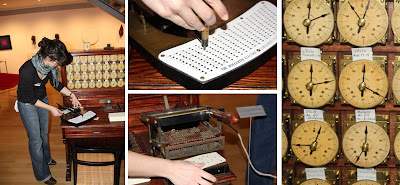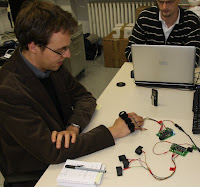Earlier I had a tele-conference with Christian Becker and Gregor Schiele (we still try to write a book 😉 and I tryed MeBeam.com for the video. And to my great suprise it work instandly and well and the conference setup took about 5 seconds – open website, chose a name for the conference, distribute the link over skype. And as one can see video adds another quality to the conversation 🙂
Category: Uncategorized
Rating your professor, teacher, doctor, or fellow students?
This morning I was coming back from Munich* on the train I got a phone call from a journalist from Radio Essen (http://www.102.2radioessen.de/). As their studio is very close to the railways station in Essen I went there spontaneously before going back to University.
* travelling from Munich (leaving at 22:30) and arriving in Essen in the morning (or Darmstadt) works fairly well and if you stay in a hotel in Stuttgart 😉 – it is surprisingly a real alternative to a night train or an early morning flight…
Mechanical Computing, Beauty of Calculating Machines

 Having learned binary calculations during the DSD course it was nice to see a machine that did binary additions, using small steel balls and gravity. On each place (1,2,4,8, …) there is space for one ball. If a second one comes to this place one moves up to the next place (carry) and one is discarded. This is implemented with very simple mechanics and the working prototype (recently build) is based on designs of Schickard (but he never built – if I am correct).
Having learned binary calculations during the DSD course it was nice to see a machine that did binary additions, using small steel balls and gravity. On each place (1,2,4,8, …) there is space for one ball. If a second one comes to this place one moves up to the next place (carry) and one is discarded. This is implemented with very simple mechanics and the working prototype (recently build) is based on designs of Schickard (but he never built – if I am correct). Moving on with binary systems and finally to silicon, we got to see the Busicom 141 – a desk calculator that uses the Intel 4004. It is impressive to see that this is not even 40 years ago – starting with 2300 transistors and 180kHz.
Moving on with binary systems and finally to silicon, we got to see the Busicom 141 – a desk calculator that uses the Intel 4004. It is impressive to see that this is not even 40 years ago – starting with 2300 transistors and 180kHz. CfP Workshop on Pervasive Advertising
Hans is visiting, generating new ideas for projects
Light themes – cool idea but with usability flaws
New project on ambient visualization – kick-off meeting in Munich
We met in Munich at Docomo Euro Labs to start a new project that is related to context and ambient visualizations. And everyone already got bunnies 😉
Related to this there is a large and very interesting project: IYOUIT. Besides other things it can record and share your context – if you have a Nokia series 60 phone you should try it out. As far as I remember it was voted best mobile experience at mobile HCI 2008.
Random Links, toys and free location data
Over the last day I have learned about some (more) interesting things out there – here are some to share with you:
- OpenGeoDB: http://opengeodb.hoppe-media.com is a database with locations in Germany and an open API
- A community effort to create an open map: http://www.openstreetmap.org/
- publishing you travels to others: http://www.dopplr.com
- Ubfunckeys: USB connected strange toy, www.ubfunkeys.com
- A communicative rabbit: http://www.nabaztag.com/
Tactile interfaces, Visit from Gordon Bolduan
One Ez430-F2013 for each student in DSD
Enrico Rukzio visits our Lab
 Enrico Rukzio (my first PhD from Munich, now lecturer in Lancaster) visited our Lab. He was make a small tour of Germany (Münster, Essen, Oldenburg). In the user interface engineering class Enrico showed some on his current work on mobile interaction, in particular mobile projectors and NFC tags. After the presentation we wondered how long it will take till kids on the train will play with mobile projections 😉
Enrico Rukzio (my first PhD from Munich, now lecturer in Lancaster) visited our Lab. He was make a small tour of Germany (Münster, Essen, Oldenburg). In the user interface engineering class Enrico showed some on his current work on mobile interaction, in particular mobile projectors and NFC tags. After the presentation we wondered how long it will take till kids on the train will play with mobile projections 😉
Biometrics will come, who will care about privacy
Will we have face-2-face PC meetings in the future?
Christmas market in Essen
 Going to Christmas market is in Germany a tradition – and obviously our group went, too 😉
Going to Christmas market is in Germany a tradition – and obviously our group went, too 😉
It is interesting that most of us had time for this “appointment” with only two days notice – usually it takes us weeks to find a date for a meeting and so far we did not find a date for a strategy meeting in the near future. Perhaps offering Glühwein (that is what you drink at Christmas markets) would help…
The quality of photos taken with a mobile phone is in difficult context (e.g. night, lights around) still not satisfactory (even with 5MP, downscaling, and image enhancing).
Known route – driving your car in mental auto-pilot?
Exporting your cars information to the mobile phone
Information vs. Mobility, Percom PC meeting in New York
 PS: it is amazing how many possiblities there are to serve coffee (and this is probably not one of the most environment friendly)
PS: it is amazing how many possiblities there are to serve coffee (and this is probably not one of the most environment friendly)
Male (88%), writing like Oscar Wilde (35%)
Exoskeletons soon in the real world
Illusions 2.0, Talk at the Museum Ludwig in Köln
My first hotel fire alarm, debugging smart environments
USA votes, election party in our lab
Geocaching, Travel bug
Technologies of Globalization 2008 in Darmstadt
I have been chairing the Stream “Aging as a Global Issue” at the conference Technologies of Globalization 2008 in Darmstadt. It is always very suprising who different research is across different diciplines…
On-Kwok Lai from Kwansei Gakuin University gave a really interesting overview on the current situation in Asia and in particular in Japan with regards the aging society. Learning more about ageing I find myself more often thinking the current “aging research” is more like treating a symptom and not looking at the real problem. And it seems the real problem: reduced reproduction in industrial states – basically we do not have enough children anymore. This leads to the obvious question: would researching into solutions and technologies that make it easier to raise children while working or studying not be the more important challenge?

In another talk Birgit Kasper reported from a study of multi-modal travel in Köln (“Patenticket”). In the trail they got people who have a yearly ticket to introduce other older people to public transport by providing them a 3 month flat-rate ticket for public transport in the region. The benefits seem to come from two sides: (1) people do not worry if they have the right ticket and (2) having a person that acts as a patron learning the public transport system is supported. If we look at the results a radical suggestion would be to introduce a car-city-tax (e.g. like London) and give in return free public transport to everyone – would this simple solution not solve many of our problems (economic, ecological, …) or would it create a two-tier society?

The social event was at castle Frankenstein – but surprisingly everyone came back in the morning unharmed 😉
History and Future of Computing and Interaction
- Home Shopping in 1999 (from 1967): http://www.youtube.com/watch?v=uO58SGiYwwo
- 1999 AD Kitchen of the Future (from 1967): http://www.youtube.com/watch?v=yFgVTUle_EM
- AT&T 1993 “You Will” Ads: http://www.youtube.com/watch?v=TZb0avfQme8
- Vision of year 2000 from year 1957: http://www.youtube.com/watch?v=I7XYXRKIqeY
Ideas in Advertisment, Privacy, German Law
Lucia and Thomas from Vodafone R&D visiting
Privacy – will our understanding change radically?
As one issue this morning we came across issues related to privacy. In particular it seems that social network analysis based on behavior in the real world (e.g. the reality mining project [1]) is creating serious interest beyond the technology people. Beyond measuring the frequency of encounters qualifying the way people interact (dominance, emotion, …) will reveal even more about social networks…
[1] Eagle, N. and (Sandy) Pentland, A. 2006. Reality mining: sensing complex social systems. Personal Ubiquitous Comput. 10, 4 (Mar. 2006), 255-268. DOI= http://dx.doi.org/10.1007/s00779-005-0046-3
2 day faculty meeting in Essen
 The last 2 day we had a meeting – with all faculty of the ICB – discussing the future challenges of work at universities in the context of our current situation. For me the this time was very well spent as I got to know many of my colleagues better and it was incredible to see the potential (from a scientific perspective as well as looking at the people) we have in our organization.
The last 2 day we had a meeting – with all faculty of the ICB – discussing the future challenges of work at universities in the context of our current situation. For me the this time was very well spent as I got to know many of my colleagues better and it was incredible to see the potential (from a scientific perspective as well as looking at the people) we have in our organization.
Trip to Dublin, Aaron’s Display Project
http://eniac.hopto.org/~whazlewo/downloads/AIS08_Full_Proceedings.pdf (~8MB)





















